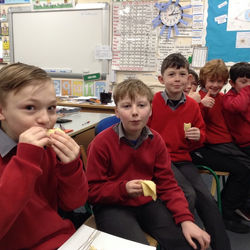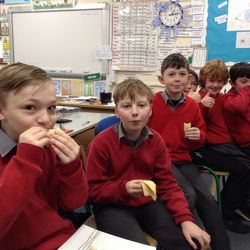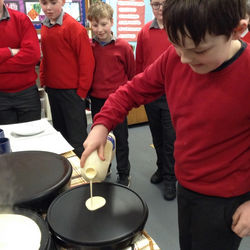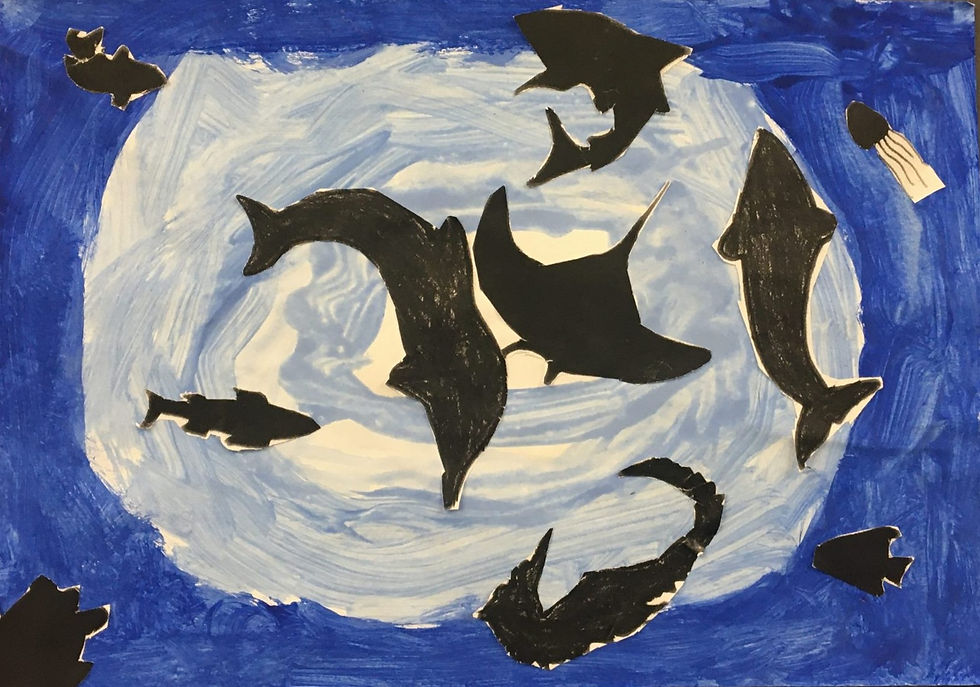
Primary Maths & Science
Step 2 - Technology
We have many other older experiments to share with you from our Science programme in 2017-2018 still on our blog - please visit and see the work of our super scientists and mathematicans. - click here
Energy and Forces
Panpipes
Strand: Energy and Forces
Unit: Sound
Maths: measures – length
We made panpipes from plastic drinking straws.
What you need
-
8 plastic drinking straws
-
sellotape
-
scissors
-
a ruler
-
pen or pencil
What we did:
We started by cutting the first straw at 20cm. Then the next straw we cut 2cm shorter, at 18cm. We cut each straw 2cm shorter than the last until we had cut them all.
We lined up the straws longest to shortest.
We used sellotape to stick them together in the pan pipes formation.
We blew across the top of the straws to get a sound. The longest straws were the deepest sound and the shortest straws had the highest sound
Sound is a type of energy made by vibrations. When any object vibrates, it causes movement in the air particles.
You will need: clingfilm, cowl, dry rice, baking tray, wooden spoon
-
Stretch the clingfilm tightly over the bowl
-
Sprinkle a small amount of rice on the clingfilm.
-
Hold the baking tray above the rice and hit the tray with the wooden spoon. The sound makes the air vibrate and when the sound waves reach the clingfilm they make the it vibrate. This makes the rice dance.
Energy and Forces
Sound
How do sound waves travel?

Energy and Forces
Energy and Forces: Sound
What you’ll need:
-
2 paper cups
-
A sharp pencil and blutac to pierce holes
-
String
Instructions:
-
Cut a piece of string 1 metre in length.
-
Pierce a small hole in the bottom of each cup.
-
Thread the string through each cup and tie knots at each end to stop it pulling through the cup.
-
Move into position with you and a friend holding the cups at a distance. Make sure the string is tight.
-
One person talks into the cup while the other puts the cup to their ear and listens.
What happened:
Speaking into the cup creates sound waves which are converted into vibrations at the bottom of the cup. The vibrations travel along the string and are converted back into sound waves at the other end so your friend can hear what you said. Sound travels through the air but it travels even better through solids such as your cup and string, allowing you to hear sounds that might be too far away when traveling through the air.
As with any science experiment it did not work for a few of the pupils but we discovered that the pupils did not have the string tight
Maths, History and Art
We used three arcs to create a Celtic knot design for St. Patrick’s Day. Many Celtic designs feature interlocking shapes. The Celtic knot is a very simple design that uses weaving to connect the three arcs. We were learning about the Book of Kells in History and the circle in Maths.
The children drew the arcs by drawing concentric circles with a compass and then cutting them out, them weaving them together to form Celtic knots.
 |  |  |
|---|---|---|
 |  |  |
 |  |  |
 Egg in vinegar |
|---|
 Day 2 |
 After 3 days |
 Bouncy egg |
 Procedural writing |
 Procedural writing |
Strand Unit: Materials
Strand unit: properties and characteristics of materials
Materials needed: 1 boiled egg, bowl, clingfilm, white vinegar, red food colouring.
Method:
-
Place the boiled egg in a bowl.
-
Cover the boiled egg with white vinegar.
-
Add a few drops of food colouring to the vinegar.
-
Cover the bowl with clingfilm.
-
Leave the egg in the bowl of vinegar for 3 days. After remove the egg.
-
Rinse the shell of the egg gently under a tap, The shell will be removed.
Result:
The vinegar (an acid) reacts with the calcium carbonate producing a salt and a gas called carbon dioxide (these are the bubbles you see). The vinegar will keep reacting with the calcium carbonate until it is all gone, leaving the egg contained in just the cell membrane.
A delicate, but bouncy egg.
Inniu Máirt na hInide agus mar sin rinneamar pancóga inniu. Bhí siad go hálainn. Bhí siad milis agus blasta. D’itheamar
iad le siúcra, líomóid, Nutella agus síoróip. Bhi sé éasca go leor na pancóga a dhéanamh agus níor thóg sé mórán ama. Míle buíochas do Ber chun cabhraigh linn.
Ag Déanamh Pancóga
 pancakes (19) |  pancakes (18) |  pancakes (17) |
|---|---|---|
 pancakes (16) |  pancakes (15) |  pancakes (14) |
 pancakes (13) |  pancakes (12) |  pancakes (11) |
 pancakes (10) |  pancakes (9) |  pancakes (8) |
 pancakes (7) |  pancakes (6) |  pancakes (5) |
 pancakes (1) |  pancakes (3) |  pancakes (2) |
Energy and Forces
A force is a push or a pull on an object. A push moves an object away from another object; a pull moves it towards another object. Forces can make objects move, get faster, slow down, stop move in a different direction or change their shape. When an object moves along a surface or another object, a force known as friction occurs. Friction makes it more difficult for the object to move.
We observed and investigated the movement of toy cars along rough and smooth surfaces.

Vitruvian Man
The Vitruvian Man is a drawing by the artist Leonardo Da Vinci based on the work of Vitruvius, a Roman architect.
Leonardo Da Vinci was born near Florence in Italy in 1452. He became a world famous artist. He died in 1519.
He was not just an artist, he was a scientist, a sculptor, a mathematician and an inventor!
Our objective was to recognise what the Vitruvian Man is and its significance to science and geometry.
The Vitruvian theory contains a total of 10 ratios between different parts of the body. As you can see we tested many of the ratios.





Seakeeper's Project - The Basking Shark


Our school is participating in The SeaKeepers Project which is a new initiative of the Green-Schools Global Citizenship Marine Environment theme. This is part of our work towards our 8th Green Flag. This project focuses on the ecology of six native Irish marine species such as The Basking Shark. As we are situated near the Atlantic ocean we are finding these lessons informative and fun. We each completed a report and some artwork on the Basking Shark which is displayed in the classroom. This month we are learning about the Grey Seal which is very common in Irish waters.
The Marshmallow Challenge
Objective: To construct a tower as high as possible using only spaghetti and masking tape. A marshmallow must be placed on top of the tower. The tallest tower standing unaided wins.
Time:20 minutes
Materials: 90 cm Masking tape, 25 sticks of spaghetti and a marshmallow.
This task involved teamwork, creativity, innovation and problem solving. Group 3 built the tallest tower but did not manage to hold the marshmallow on top.
All of the pupils were engaged in the task and worked very well in their groups.


.png)

_edited.png)

.png)

































